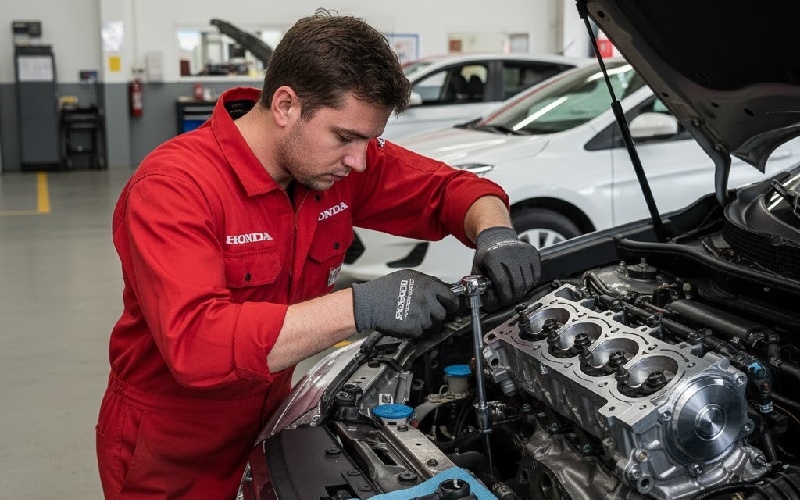What powers the 2025 CR-V Sport AWD?
The Honda CR-V Sport AWD continues the sixth generation’s impressive powertrain options. The Sport AWD trim features a robust turbocharged 1.5-litre four-cylinder engine producing 190 horsepower at 6,000 rpm and 179 Newton-metres of torque available from 1,700 to 5,000 rpm. This responsive engine pairs with a continuously variable transmission (CVT) that delivers smooth acceleration while maintaining excellent fuel efficiency.

The powertrain provides a balanced power-to-weight ratio of approximately 8.7 kg/hp, offering confident highway passing maneuvers and stable performance in various driving conditions. The Sport AWD engine has been refined for the latest model year to maintain the perfect balance between power delivery and fuel consumption.
How does the CR-V Sport AWD engine compare to other trims?
The CR-V lineup offers various powertrain options across its different trims. The LX 2WD and LX AWD feature the same turbocharged 1.5-litre engine as the Sport AWD, delivering identical power output. Where these trims differ is in their drivetrain configuration and subsequent performance characteristics.
Moving up to the EX-L Hybrid and Touring Hybrid trims reveals a significant powertrain change. These models utilize a naturally aspirated, Atkinson-cycle 2.0-litre four-cylinder engine paired with an electric propulsion motor, a motor-generator, and a 1.06 kWh battery pack. This sophisticated hybrid system generates a combined 204 horsepower and an impressive 247 Newton-metres of torque, with the electric motor providing maximum torque from 0 to 2,000 rpm.
What fuel efficiency can drivers expect?
The CR-V Sport AWD demonstrates respectable fuel economy despite its all-wheel-drive configuration. Drivers can expect approximately 9.1 L/100 km during city driving, 7.6 L/100 km on highways, and a combined rating of 8.4 L/100 km. These figures position the Sport AWD as one of the more fuel-efficient non-hybrid options in the compact crossover segment.
For comparison, the front-wheel-drive LX 2WD achieves slightly better efficiency with ratings of 8.4 L/100 km city, 7.1 L/100 km highway, and 7.8 L/100 km combined. Meanwhile, the hybrid models significantly outperform their non-hybrid counterparts, delivering impressive figures of 6.0 L/100 km city, 6.9 L/100 km highway, and 6.4 L/100 km combined.
How capable is the all-wheel drive system?
The Sport AWD features the real-time Honda AWD system, which intelligently distributes torque between the front and rear wheels depending on driving conditions. While primarily operating as a front-wheel-drive vehicle during normal driving for optimal efficiency, the system can instantly redirect power to the rear wheels when slippage is detected.
With 208 mm of ground clearance, the Sport AWD offers practical capability for light off-road excursions and confident handling in adverse weather conditions. The approach and departure angles of 17.7 and 22.1 degrees, respectively, provide reasonable clearance for navigating rough terrain without compromising the vehicle’s on-road manners.
What are the performance advantages of the turbocharger?
The turbocharged engine in the Sport AWD offers several performance benefits. Most notably, it delivers peak torque at a relatively low 1,700 rpm, which translates to responsive acceleration from a stop and excellent mid-range power for overtaking maneuvers.
The turbocharger also helps maintain performance at higher altitudes where naturally aspirated engines typically suffer power loss. Additionally, the turbocharging technology allows the 1.5-litre engine to deliver power comparable to a larger displacement engine while maintaining better fuel efficiency during normal driving conditions.
Five Facts About the 2025 Honda CR-V Sport AWD
1. The CR-V Sport AWD turbocharged engine features variable valve timing and electronic wastegate control to optimize power delivery across the entire rev range.
2. Despite having less horsepower than the hybrid models, the Sport AWD can tow up to 680 kg compared to the hybrids’ 453 kg capacity.
3. The Sport AWD CVT transmission incorporates a special “G-Design” shift logic that simulates the feeling of traditional gear changes during acceleration.
4. The latest model utilizes an active noise cancellation system that monitors and counteracts engine noise frequencies to create a quieter cabin experience.
5. The Sport AWD features unique suspension tuning with higher spring rates and revised damper settings compared to the base LX trims for more responsive handling.
Questions and Answers About the 2025 Honda CR-V Sport AWD
What type of engine does the CR-V Sport AWD use?
- It uses a turbocharged 1.5-litre four-cylinder engine.
How much horsepower does the CR-V Sport AWD produce?
- It generates 190 horsepower at 6,000 rpm.
What is the torque output of the CR-V Sport AWD?
- It produces 179 Newton-metres of torque available from 1,700 to 5,000 rpm.
What transmission is paired with the Sport AWD engine?
- The engine has a continuously variable transmission (CVT).
How does the fuel efficiency compare between the Sport AWD and Hybrid trims?
- The Sport AWD achieves 9.1/7.6/8.4 L/100 km (city/highway/combined), while the hybrid models deliver 6.0/6.9/6.4 L/100 km.
What is the ground clearance of the CR-V Sport AWD?
- It has 208 mm of ground clearance.
What type of fuel does the CR-V Sport AWD require?
- It runs on regular unleaded fuel.
How does the power-to-weight ratio affect performance?
- The 8.7 kg/hp ratio provides balanced acceleration and fuel efficiency for daily driving.
What are the approach and departure angles of the CR-V Sport AWD?
- The approach angle is 17.7 degrees, and the departure angle is 22.1 degrees.
How much cargo space does the CR-V Sport AWD offer?
- It provides 1,113 litres of cargo space with the rear seats up and 2,166 litres with the seats folded down.




